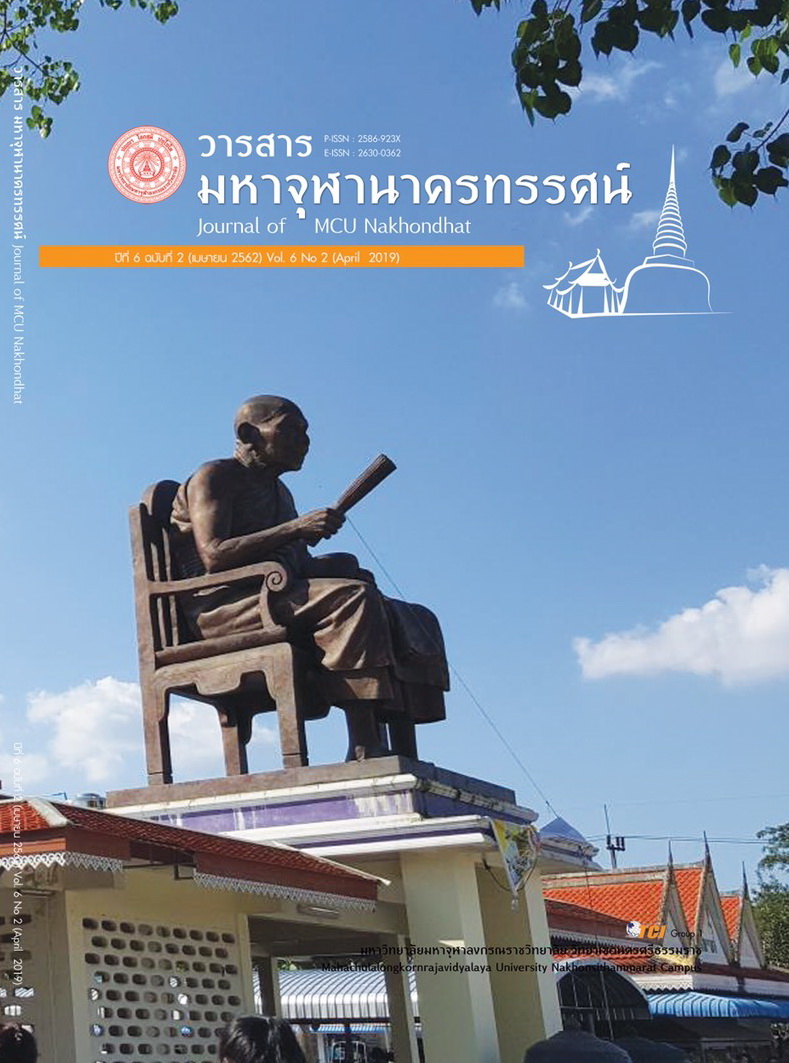GUIDELINES FOR THE DEVELOPMENT AND ENHANCEMENT OF LABOR PRODUCTIVITY IN THAILAND'S SERVICE SECTOR
Main Article Content
Abstract
The purposes of this research were: 1) to analyze the importance of increasing labor productivity in the service sector of the Thai economy, 2) to study the desirable characteristics of service industry personnel, and 3) to find the ways to develop and increase labor productivity in the service sector of the Thai economy. This research used both quantitative and qualitative methodologies. A sample of this research was used for the Input-Output Table in 2010 for quantitative research. The qualitative research was done as a quota sampling made up of in-depth interviews. The interviewees were required to have a job as a middle level manager or higher or to have been working in the field for at least 10 years, including one person per sub-service industry, for a total of eight persons. Convenience sampling was used to complete, according to the number of samples. The quantitative research calculated labor productivity in order to determine the return value of the labor coefficient to measure labor productivity in the service sector of the Thai economy. The qualitative research was an accomplished by undertaking in-depth interviews using a questionnaire, which consisted of three parts: 1) What are the desirable characteristics of service sector personnel such as knowledge and specific techniques, etc. 2) How should the development of personnel in the service sector of Thailand be undertaken And 3) Do you have any recommendations? Quality testing of questionnaires by three experts was undertaken to verify the content validity of the questions. They evaluated the IOC (Consistency Index) to test whether each question matched the research objective, with an IOC of 1.00.
The results of the study showed that:
The growth of labor productivity in the Thai service sector is still lower than the manufacturing sectors. Interview results provided the guidelines to increase labor productivity in the service sector of the Thai economy personnel in the service industry. Employees must have qualifications in three areas: 1) competency, 2) knowledge and ability, and 3) other desirable characteristics of service industry personnel. For guidelines for personnel development in the service sector for those involved in producing graduates, whether at a university or a institutions that will produce a service personnel should proceed as follows: 1) Should ask what knowledge and skills do employers look for when hiring for their workplace., 2) promote that the personnel of the education sector attend various training courses so that they can learn new knowledge skills and technology to bring back to the classrooms. The organization which in service industry hires employees should do the following: 1) provide training for knowledge, skills, understanding of tasks / duties according to the duties assigned, 2) Should cultivate an organizational learning society and support the corporate culture for knowledge sharing., and 3) Should encourage and support personnel to create new knowledge by giving them education Including distributing work appropriately and to give everyone the opportunity to present their work, practice thinking and practice learning, let employees solve problems and find a solution by themselves.
Article Details
References
ดวงตา ภัทโรพงศ์ พย.ม. (2558) . ความคาดหวังและการรับรู้คุณภาพการบริการพยาบาลของผู้รับบริการในหน่วยงานผู้ป่วยนอก โรงพยาบาลศูนย์สุราษฎร์ธานี. วารสารวิชาการแพทย์ เขต 11, (29) , 365 – 373.
ธันยานี เคนคำภา . (2559) . กลยุทธก์ารค้าปลีก (ร้านสะดวกซื้อ) ที่ส่งผลต่อพฤติกรรมการซื้อสินค้าของผู้บริโภคใน ร้าน Banthon Oriental Supermarket in Bath, United Kingdom . บริหารธุรกิจมหาบัณฑิต : มหาวิทยาลัยกรุงเทพ .
ปิยะฉัตร จารุธีรศานต์. (2560) . กลยุทธ์การจัดการโลจิสติกส์และการพัฒนาบุคลากร.วารสารวิชาการคณะบริหารธุรกิจ. มหาวิทยาลัยเทคโนโลยีราชมงคลธัญบุรี.
พิษณุ อิ่มวิญญาณ และ พนิตกุลศิริ. (2554) . การจัดการร้านค้าปลีกที่มีอิทธิพลต่อพฤติกรรมการซื้อสินค้าของผู้บริโภค:การศึกษาร้านสะดวกซื้อในกรุงเทพมหานคร. วารสารวิจัยและพัฒนา วไลยอลงกรณ์ ในพระบรมราชูปถัมภ์, 10(3) , 349-359.
ภัควัฒน์ อินทรวงษ์โชติ, ปภัศร ชัยวัฒน์, ธนัญญา วสุศรี, ทวีศักดิ์ กฤษเจริญ และจิรชัย พุทธกุลสมศิร. (2556) . คุณภาพการให้บริการของผู้ประกอบการโลจิสติกส์ประเทศไทยและลาว. วารสารวิจัยและพัฒนา มจธ., 36(4) , 465-475.
ภาคิไนย อักษรแก้ว. (2553) . ทัศนคติของพนักงานการไฟฟ้าส่วนภูมิภาค ที มีต่อระบบการบริหารจัดการห้องประชุม บทความวิจัย. บัณฑิตวิทยาลัย: มหาวิทยาลัยนอร์ทกรุงเทพ.
มังกร ตัณฑะศิลป์, สุกัญญา เอมอิ่มธรรม และ เพ็ญศรี เจริญวานิช. (2556) . วารสารบัณฑิตศึกษา มนุษยศาสตร์และสังคมศาสตร์, 2(1) , 33-50.
รุ่งโรจน์ สงสระบุญ. (2560) . ความพึงพอใจการใช้บริการธนาคารอิสลามแห่งประเทศไทย สาขานนทบุรี. วารสารวิชาการ มหาวิทยาลัยธนบุรี, 11(25) , 68-77.
วรวรรณ ศิลมัฐ. (2555) . การเพิ่มประสิทธิภาพการให้บริการของธนาคารออมสิน สาขาแกลง จังหวัดระยอง. กรุงเทพมหานคร: ปริญญานิพนธ์การศึกษามหาบัณฑิต มหาวิทยาลัยหอการค้าไทย.
วินัสยา สุริยาธานินทร. (2558) . ภาคบริการแรงขับเคลื่อนใหม่ของระบบเศรษฐกิจไทย? เรียกใช้เมื่อ 7 พฤศจิกายน 2561 จาก https://www.bot.or.th/Thai/ResearchAndPublications/DocLib_/article28_04_58.pdf
ศรอนงค์ เปิดโปร่ง และธีระ ฤทธิรอด. (2559) . การพัฒนาบุคลากรด้านการให้บริการของสำนักงานส่งเสริมการปกครองท้องถิ่น จังหวัดร้อยเอ็ด. วารสารวิจัยและพัฒนา มหาวิทยาลัยราชภัฏเลย, 11(37) , 33-39.
สำนักงานสถิติแห่งชาติ. (2559) . การสำรวจภาวะการทำงานของประชากรทั่วราชอาณาจักร. สำนักงานสถิติแห่งชาติ: กระทรวงดิจิทัลเพื่อเศรษฐกิจและสังคม ประเทศไทย.
สุชน ยิ้มรัตนบวร. (2558) . ปัจจัยที่มีผลต่อความเป็นไปได้ในการออกแบบอาคารพักอาศัยรวม :กรณีศึกษา Baron Residence ย่านบางกะปิ. Veridian E- journal, Silpakorn University, 8 (3) , 1269-1283.
Sauian, M.S., Kamarudin, N. & Rani,R.M. (2013) . Labor Productivity of services Sector in Malaysia: Analysis using Input-Output Approach. International Conference on Economics and Business Research.
The Bank of Thailand. (2017) . Middle Income Trap. Economic research article: Bangkok.


